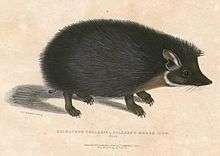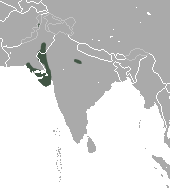Indian long-eared hedgehog
The Indian long-eared hedgehog (Hemiechinus collaris) is a small species of mammal native to northern India and Pakistan. It is insectivorous and nocturnal.[2][3]
| Indian long-eared hedgehog | |
|---|---|
 | |
| Indian long-eared hedgehog illustration | |
| Scientific classification | |
| Kingdom: | Animalia |
| Phylum: | Chordata |
| Class: | Mammalia |
| Order: | Eulipotyphla |
| Family: | Erinaceidae |
| Genus: | Hemiechinus |
| Species: | H. collaris |
| Binomial name | |
| Hemiechinus collaris (Gray, 1830) | |
 | |
| Indian long-eared hedgehog range | |
Description
The Indian long-eared hedgehog is a relatively small hedgehog (~17 cm, 200–500 grams). It is a nocturnal animal that is often found inhabiting burrows.[3] Similar to most hedgehogs it has spines on its back, embedded into a muscle sheath. This sheath forms a bag-like structure that the animal can hide inside for protection. It can also erect its spines to further protect from predators. The Indian long-eared hedgehog has a well developed set of senses because of its large ears, eyes and whiskers near its snout.[4] These senses, especially smell, help them find food and/or a possible partner.[5]
Diet
The Indian long-eared hedgehog is insectivorous, feeding on small insects. Because of their arid desert habitat they often receive most of the water they need from their food supply.[6]
Distribution
The Indian long-eared hedgehog is found in India (Gujarat, Rajasthan and Uttar Pradesh) and Pakistan (North West Frontier Province, Punjab and Sindh). It experiences extreme heat in the months of May and June and very cold weather in December and January.[6]
Reproduction
They are seasonal breeders. The males are active from March to August[3] while the females are active from April to August.[6] It is notable for a quite complex mating ritual that involves "dancing" around females for several days before mating.
References
- Molur, S. (2008). Hemiechinus collaris. In: IUCN 2012. IUCN Red List of Threatened Species. Version 2012.2.
- Hutterer, R. (2005). Wilson, D.E.; Reeder, D.M. (eds.). Mammal Species of the World: A Taxonomic and Geographic Reference (3rd ed.). Johns Hopkins University Press. p. 215. ISBN 978-0-8018-8221-0. OCLC 62265494.
- Goyal, R. P. & Mathur, R. S. (1974). "Anatomic, Histologic and Certain Enzymatic Studies on the Male Genital Organs of Hemiechinus auritus collaris Gray, the Indian Long Eared Hedgehog". Acta Zoologica. 55: 47. doi:10.1111/j.1463-6395.1974.tb00178.x.
- Catania, K. (2005). "Evolution of sensory specialization in insectivores". The Anatomical Record Part A: Discoveries in Molecular, Cellular, and Evolutionary Biology. 287A (1): 1038–50. doi:10.1002/ar.a.20265. PMID 16215983.
- Poddar-Sarkar, M.; Raha, P.; Bhar, R.; Chakraborty, A. & Brahmachary, R. (2011). "Ultrastructure and lipid chemistry of specialized epidermal structure of Indian porcupines and hedgehog". Acta Zoologica. 92 (2): 134. doi:10.1111/j.1463-6395.2010.00452.x.
- Sharma, A. & Mathur, R. S. (1974). "Histomorphological Changes in the Reproductive Tract of Female Hemiechinus auritus collaris, Gray in Relation to the Estrous Cycle". Acta Zoologica. 55 (4): 235. doi:10.1111/j.1463-6395.1974.tb00199.x.
